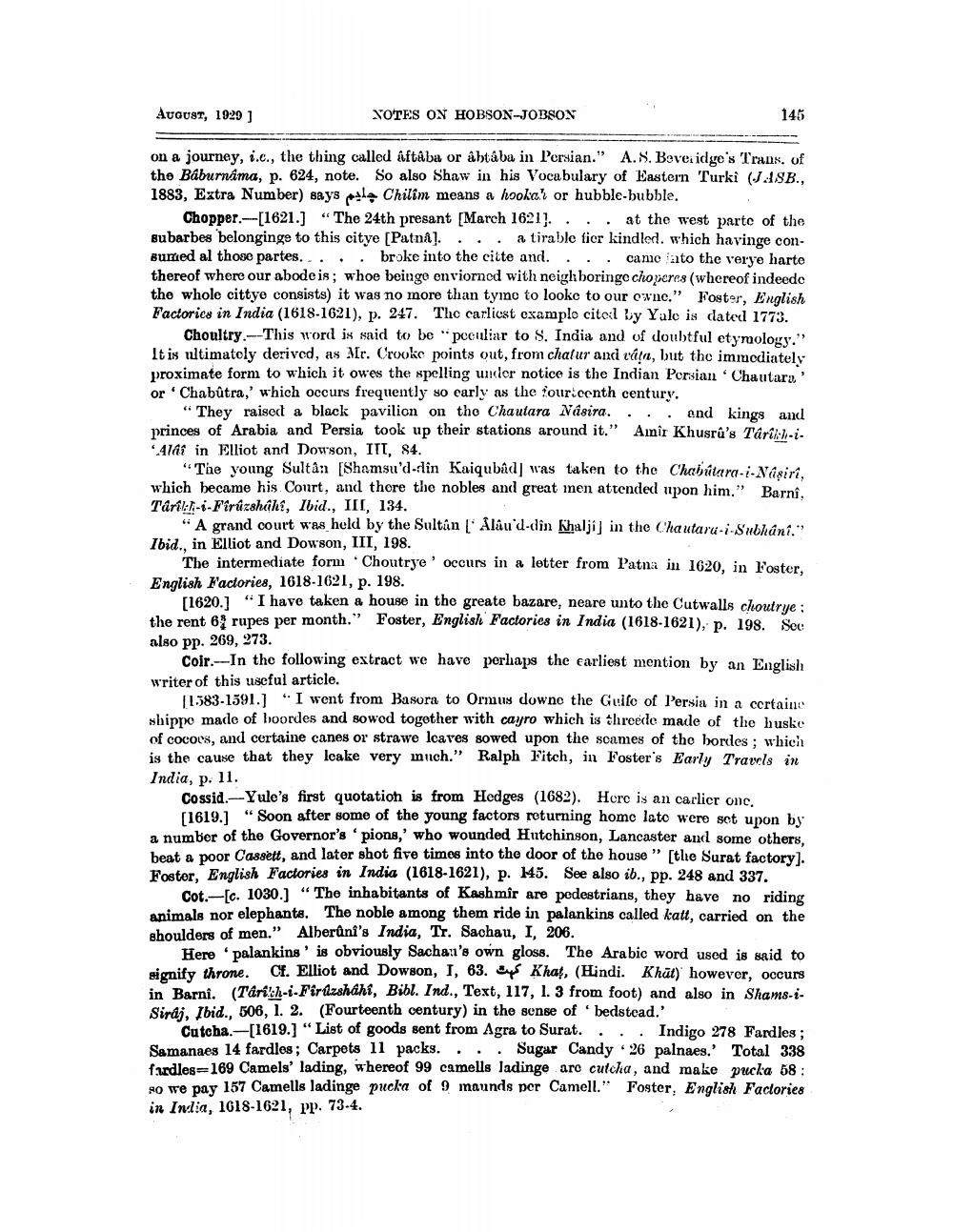________________
August, 1929 )
XOTES ON HOBSON-JOBSON
145
on a journey, i.c., the thing called aftaba or áhtába in Persian." A.S. Beveridge's Trans, of the Baburnama, p. 624, note. So also Shaw in his Vocabulary of Eastern Turki (JASB., 1883, Extra Number) says a Chilim means a hookah or hubble-bubble.
Chopper.--11621.) "The 24th presant [March 1621)...at the west part of the subarbes belonginge to this citye (Patna.... a tirable tier kindled, which havinge conburned al those partes...broke into the citte and.... came ato the verye harte thereof where our abode is; whoe beinge enviorned with neighboringe choperes (whereof indeede the whole cittye consists) it was no more than tyme to looke to our exne." Foster, English Factories in India (1618-1621), p. 247. The earliest examplo citel by Yalo is dated 1773.
Choultry. This word is said to be peculiar to S. India and of doubtful etymology." It is ultimately derived, as Mr. Crooke points out, from chalur and cara, but the immediately proximate form to which it owes the spelling under notice is the Indian Persian Chautars' or Chabútra,' which occurs frequently so early as the four centh century.
“They raised a black pavilion on the Chautara Nasira.... and kings and princes of Arabia and Persia took up their stations around it." Amir Khusru's Tarikh-i. *.4141 in Elliot and Dowson, III, 84.
"The young Sultan [Shamsu'd-rlin Kaiquband was taken to the Chabitara-i-Nasiri, which became his Court, and there the nobles and great men attended upon him." Barni. Tarikh-i-Firúzshahs, Ibid., III, 134.
“A grand court was held by the Sultan Alau'd-din Khalji] in the Chautaru-:-Subháni." Ibid., in Elliot and Dowson, III, 198.
The intermediate form Choutrye ' occurs in a letter from Patna in 1620, in Foster. English Factories, 1618-1621, p. 198.
11620.1 "I have taken a house in the greate bazare, neare unto the Cutwalls choutrije: the rent 6% rupes per month." Foster, English Factories in India (1618-1621), p. 198. See also pp. 269, 273.
Coir. In the following extract we have perlaps the earliest mention by an English writer of this useful article.
11.583-1591.) "I went from Basora to Ormus downe the Guife of Persia in a certain shippo made of boordes and sowod together with cayro which is threede made of the huske of cocoes, and certaine canes or strawe lcares sowed upon the scames of the bordes; which is the cause that they leake very much." Ralph Fitch, in Foster's Early Travels in India, p. 11.
Cossid.--Yule's first quotation is from Hedges (1682). Here is an carlicr onc.
11619.] "Soon after some of the young factors returning home lato were set upon by number of the Governor's 'pions,' who wounded Hutchinson, Lancaster and some others, beat a poor Cassett, and later shot five times into the door of the house " [tle Surat factoryl. Fostor, English Factories in India (1618-1621), p. 145. See also ib., pp. 248 and 337.
Cot [c. 1030.) “The inhabitants of Kashmîr are pedestrians, they have no riding animals nor elephants. The noble among them ride in palankins called katt, carried on the shoulders of men." Alberûni's India, Tr. Sachau, I, 206.
Here palankins' is obviously Sachau's own gloss. The Arabic word used is said to signify throne. Cf. Elliot and Dowson, I, 63. Syr Khat, (Hindi. Khūt) however, occurs in Barni. (Tarich-1-Firuzshahi, Bibl. Ind., Text, 117, 1. 3 from foot) and also in Shams-sSirdi. Ibid., 106, 1. 2. (Fourteenth century) in the sense of 'bedstead.'
Cutcha.-[1619.] "List of goods sent from Agra to Surat.... Indigo 278 Fardles ; Samannes 14 fardles; Carpots 11 packs... Sugar Candy 26 palnaes.' Total 338 fardles 169 Camels' lading, whereof 99 camells ladinge aro culcha, and make pucka 68: 90 we pay 157 Camells ladinge pucka of 9 maunds per Camell." Foster, English Factories in Inlia, 1618-1621, PP. 73-4.




